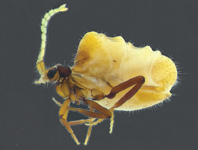Abstract
The discovery of a new genus of Heatherellidae in New Zealand has led us to revise this enigmatic family and its constituent genera. Aheatherella n. gen., based on A. mira n. sp. from the North Island of New Zealand, lacks some of the derived character states that link the Australian Heatherella, most notably the lack of sexual dimorphism in the dorsal shields and in the presence of peritremes in adult Aheatherella. Heatherella osleri n. sp. is described from New South Wales, extending the distribution of this genus beyond Queensland. New collection records of H. callimaulos and a key to the genera and species of the family are provided. We propose that the Heatherellidae—previously placed in its own cohort outside the Gamasina—are best considered a superfamily of gamasine mites within the subcohort Epicriiae.
References
Alberti, G. (2013) Fine structure of the idiosomatic protuberances in the gamasid mite Epicrius mollis (Acari, Gamasida, Epicriidae). International Journal of Acarology, 39, 481–493.
https://doi.org/10.1080/01647954.2013.823462Beaulieu, F. & Walter, D.E. (2007) Predation in suspended and forest floor soils: observations of Australian mesostigmatic mites. Acarologia, 47, 43–54.
Beaulieu, F., Walter, D.E., Proctor, H.C. & Kitching, R.L. (2010) The canopy starts at 0.5 m: predatory mites (Acari: Mesostigmata) differ between rain forest floor soil and suspended soil at any height. Biotropica, 42, 704–709.
https://doi.org/10.1111/j.1744-7429.2010.00638.xDohrn, H. (1864) Versuch einer monographie der Dermapteren. Stettiner Entomologische Zeitung, 25, 285–296.
Evans G.O. (1963) Observations on the chaetotaxy of the legs in free-living Gamasina (Acari: Mesostigmata). Bulletin of the British Museum Natural History Zoology, 10, 277–303.
https://doi.org/10.5962/bhl.part.20528Klompen, H., Lekveishvili, M. & Black, W.C. (2007) Phylogeny of parasitiform mites (Acari) based on rRNA. Molecular Phylogenetics and Evolution, 43, 936–951.
https://doi.org/10.1016/j.ympev.2006.10.024Kramer, P. (1876) Zur Naturgeschichte einiger Gattungen aus der Familie der Gamasiden. Archiv für Naturgeschichte, 42, 46–105.
Lindquist, E.E. (1994) Some observations on the chaetotaxy of the caudal body region of gamasine mites (Acari: Mesostigmata), with a modified notation for some ventrolateral body setae. Acarologia, 35, 323–326.
Lindquist, E.E. & Evans, G.O. (1965) Taxonomic concepts in the Ascidae, with a modified setal nomenclature for the idiosoma of the Gamasina (Acarina: Mesostigmata). Memoirs of the Entomological Society of Canada, 47, 1–64.
https://doi.org/10.4039/entm9747fvLindquist, E.E. & Moraza, M.L. (1998) Observations on homologies of idiosomal setae in Zerconidae (Acari: Mesostigmata), with modified notation for some posterior body setae. Acarologia, 39, 203–226.
Lindquist, E.E., Krantz, G.W. & Walter, D.E. (2009a) Classification. In: Krantz, G.W. & Walter, D.E. (Eds.), A Manual of Acarology. 3rd Edition. Texas Tech University Press, Lubbock, Texas, pp. 97–103.
Lindquist, E.E., Krantz, G.W. & Walter, D.E. (2009b) Order Mesostigmata. In: Krantz, G.W. & Walter, D.E. (Eds.), A Manual of Acarology. 3rd Edition. Texas Tech University Press, Lubbock, Texas, pp. 124–232.
Moraza, M.L. (2005) Revised diagnosis of Epicrius Canestrini and Fanzago, 1877 and description of four new species (Acari: Mesostigmata: Epicriidae). International Journal of Acarology, 31, 341–354.
https://doi.org/10.1080/01647950508683674Moraza, M.L. & Lindquist, E.E. (1998) Coprozerconidae, a new family of zerconoid mites from North America (Acari: Mesostigmata: Zerconoidea). Acarologia, 39, 291–313.
Osler, G.H.R. & Beattie, A.J. (2001) Contribution of oribatid and mesostigmatid soil mites in ecologically based estimates of global species richness. Austral Ecology, 26, 70–79.
Seeman, O.D. (2002) Mites and Passalid Beetles: Diversity, Taxonomy, and Biogeography. PhD Thesis, The University of Queensland, Brisbane, 330 pp.
Seeman, O.D. (2007) A new species of Paradiplogynium (Acari: Diplogyniidae) from Titanolabis colossea (Dohrn) (Dermaptera: Anisolabididae), Australia’s largest earwig. Zootaxa, 1368, 31–38.
Seeman, O.D. (2012a) Diplogyniidae (Acari: Mesostigmata) associated with Panesthia cockroaches (Blattodea: Blaberidae). Zootaxa, 3163, 33–53.
Seeman, O.D. (2012b) A new genus of Blattisociidae (Acari: Mesostigmata: Phytoseioidea) from Australian burrowing carabid beetles. International Journal of Acarology, 38, 533–544.
https://doi.org/10.1080/01647954.2012.704395Solomon, L. (1978) Epicriidae from the Romanian fauna. Revue Roumaine de Biologie, Serie de Biologie Animale, 23, 9–14.
https://doi.org/10.1080/01647959708683559Walter, D.E. (1997) Heatherellidae - a new family of Mesostigmata (Acari: Parasitiformes) based on two new species from rainforest litter in Australia. International Journal of Acarology, 23, 167–175.
Walter, D.E. & Krantz, G.W. (2009) Collecting, rearing, and preparing specimens. In: Krantz, G.W. & Walter, D.E. (Eds.), A Manual of Acarology. 3rd Edition. Texas Tech University Press, Lubbock, Texas, pp. 83–96.

